Numerical Study on the Effect of Pre-Strain on Detwinning in Rolled Mg Alloy AZ31
Abstract
:1. Introduction
2. Constitutive Model
3. Results and Discussion
4. Conclusions
Author Contributions
Funding
Institutional Review Board Statement
Informed Consent Statement
Data Availability Statement
Conflicts of Interest
References
- Park, S.H.; Hong, S.G.; Lee, C.S. In-plane anisotropic deformation behaviour of rolled Mg-3Al-1Zn alloy by initial {10-12} twins. Mater. Sci. Eng. A 2013, 570, 149–163. [Google Scholar] [CrossRef]
- Sarker, D.; Chen, D.L. Dependence of compressive deformation on pre-strain and loading direction in an extruded magnesium alloy: Texture, twinning and de-twinning. Mater. Sci. Eng. A 2014, 596, 134–144. [Google Scholar] [CrossRef]
- Barnett, M.R.; Keshavarz, Z.; Beer, A.G.; Atwell, D. Influence of grain size on the compressive deformation of wrought. Acta Mater. 2004, 52, 5093–5103. [Google Scholar] [CrossRef]
- Jiang, L.; Jonas, J.J.; Luo, A.A.; Sachdev, A.K.; Godet, S. Influence of {10-12} extension twinning on the flow behaviour of AZ31 Mg alloy. Mater. Sci. Eng. A 2007, 445, 302–309. [Google Scholar]
- Dong, S.; Yu, Q.; Jiang, Y.Y.; Dong, J.; Wang, F.H.; Jin, L.; Ding, W.J. Characteristic cyclic plastic deformation in ZK60 magnesium alloy. Int. J. Plast. 2017, 91, 25–47. [Google Scholar] [CrossRef] [Green Version]
- Zhang, M.J.; Zhang, H.; Ma, A.X.; Lorca, J. Experimental and numerical analysis of cyclic deformation and fatigue behavior of a Mg-RE alloy. Int. J. Plast. 2021, 139, 102885. [Google Scholar] [CrossRef]
- Dong, S.; Jiang, Y.Y.; Dong, J.; Wang, F.H.; Ding, W.J. Electron backscatter diffraction observations of twinning–detwinning evolution in a magnesium alloy subjected to large strain amplitude cyclic loading. Mater. Des. 2015, 65, 762–765. [Google Scholar] [CrossRef] [Green Version]
- Yin, S.M.; Yang, H.J.; Li, S.X.; Wu, S.D.; Yang, F. Cyclic deformation behaviour of as-extruded Mg-3%Al-1%Zn. Scr. Mater. 2010, 58, 751–7546. [Google Scholar] [CrossRef]
- Lou, X.Y.; Li, M.; Boger, P.K.; Agnew, S.R.; Wagoner, R.H. Hardening evolution of AZ31B Mg sheet. Int. J. Plast. 2007, 23, 444–486. [Google Scholar] [CrossRef]
- Wu, W.; Qiao, H.; An, K.; Guo, X.Q.; Wu, P.D.; Liaw, P.K. Investigation of deformation dynamics in a wrought magnesium alloy. Int. J. Plast. 2014, 62, 105–120. [Google Scholar] [CrossRef] [Green Version]
- Partridge, P.G. Cyclic twinning in fatigued close-packed hexagonal metals. Philos. Mag. 1965, 12, 1043–1054. [Google Scholar] [CrossRef]
- Sarker, D.; Friedman, J.; Chen, D.L. Influence of pre-strain on de-twinning activity in an extruded AM30 magnesium alloy. Mater. Sci. Eng. A 2014, 605, 73–79. [Google Scholar] [CrossRef]
- Sarker, D.; Chen, D.L. Detwinning and strain hardening of an extruded magnesium alloy during compression. Scr. Mater. 2012, 67, 165–168. [Google Scholar] [CrossRef]
- Xin, Y.C.; Zhou, X.J.; Liu, Q. Suppressing the tension-compression yield asymmetry of Mg alloy by hybrid extension twins structure. Mater. Sci. Eng. A 2013, 567, 9–13. [Google Scholar] [CrossRef]
- Xin, Y.C.; Zhou, X.J.; Wu, Y.; Yu, H.H.; Liu, Q. Deformation behaviour and mechanical properties of composite twin structures under different loading paths. Mater. Sci. Eng. A 2015, 640, 118–128. [Google Scholar] [CrossRef]
- Lou, C.; Zhang, X.Y.; Ren, Y. Improved strength and ductility of magnesium alloy below micro-twin lamellar structure. Mater. Sci. Eng. A 2014, 614, 1–5. [Google Scholar] [CrossRef]
- Lou, C.; Zhang, X.Y.; Wang, R.H.; Liu, Q. Mechanical behaviour and microstructural characteristics of magnesium alloy containing {10-12} twin lamellar structure. J. Mater. Res. 2013, 28, 733–739. [Google Scholar] [CrossRef]
- Lou, C.; Zhang, X.Y.; Wang, R.H.; Duan, G.L.; Liu, Q. Effects of untwining and {10-12} twin lamellar structure on the mechanical properties of Mg alloy. Acta Metall. Sin. 2013, 49, 291–296. [Google Scholar] [CrossRef]
- He, J.J.; Liu, T.M.; Xu, S.; Zhang, Y. The effects of compressive pre-deformation on yield asymmetry in hot-extruded Mg-3Al-1Zn alloy. Mater. Sci. Eng. A 2013, 579, 1–8. [Google Scholar] [CrossRef]
- He, J.J.; Liu, T.M.; Zhang, Y.; Xu, S.; Lu, L.W.; Tan, J. Deformation behaviour of hot extruded Mg Alloy AZ31 during compressive deformation. Mater. Sci. Technol. 2013, 29, 177–183. [Google Scholar] [CrossRef]
- Tomé, C.N.; Lebensohn, R.A.; Kocks, U.F. A model for texture development dominated by deformation twinning—application to zirconium alloys. Acta Metall. Mater. 1991, 39, 2667–2680. [Google Scholar] [CrossRef] [Green Version]
- Proust, G.; Tomé, C.N.; Jain, A.; Agnew, S.R. Modeling the effect of twinning and detwinning during strain-path changes of magnesium alloy AZ31. Int. J. Plast. 2009, 25, 861–880. [Google Scholar] [CrossRef]
- Proust, G.; Tomé, C.N.; Kaschner, G.C. Modeling texture, twinning and hardening evolution during deformation of hexagonal materials. Acta Mater. 2007, 55, 2137–2148. [Google Scholar] [CrossRef]
- Hama, T.; Takuda, H. Crystal plasticity finite-element simulation of deformation behavior in a magnesium alloy sheet considering detwinning. Steel Res. Int. 2012, 1115–1118. Available online: https://www.researchgate.net/publication/279652764_Crystal_plasticity_finite-element_simulation_of_deformation_behavior_in_a_magnesium_alloy_sheet_considering_detwinning (accessed on 15 September 2021).
- Yu, C.; Kang, G.Z.; Kan, Q.H. Crystal plasticity based constitutive model for uniaxial ratchetting of polycrystalline magnesium alloy. Comput. Mater. Sci. 2014, 84, 63–67. [Google Scholar] [CrossRef]
- Li, H.; Kang, G.Z.; Yu, C. Modeling uniaxial ratchetting of magnesium alloys by a new crystal plasticity considering dislocation slipping, twinning and detwinning mechanisms. Int. J. Mech. Sci. 2020, 179, 105660. [Google Scholar] [CrossRef]
- Wang, H.; Wu, P.D.; Tomé, C.N.; Wang, J. A constitutive model of twinning and detwinning for HCP polycrystals. Mater. Sci. Eng. A 2012, 555, 93–98. [Google Scholar] [CrossRef]
- Wang, H.; Wu, P.D.; Wang, J.; Tomé, C.N. A physics-based crystal plasticity model for hexagonal close packed (HCP) crystals including both twinning and de-twinning mechanisms. Int. J. Plast. 2013, 49, 36–52. [Google Scholar] [CrossRef]
- Wang, H.; Wu, P.D.; Tomé, C.N.; Huang, Y. A finite-strain elastic-viscoplastic self-consistent model for.polycrystalline materials. J. Mech. Phys. Solids 2010, 58, 594–612. [Google Scholar] [CrossRef]
- Zhao, L.; Guo, X.Q.; Chapuis, A.; Xin, Y.C.; Liu, Q.; Wu, P.D. Strain-path dependence of {10-12} twinning in a rolled Mg-3Al-1Zn alloy: Influence of twinning model. Metall. Mater. Trans. A 2019, 50, 118–131. [Google Scholar] [CrossRef]
- Wang, H.; Wu, P.D.; Wang, J. Numerical assessment of the role of slip and twinning in magnesium alloy AZ31B during loading path reversal. Metall. Mater. Trans. A 2015, 46, 3079–3090. [Google Scholar] [CrossRef]
- He, Q.C.; Zhang, X.D.; Qiao, H.; Wang, H.; Wu, P.D. Modeling the effect of pre-straining on mechanical behavior of magnesium alloy sheet. Appl. Phys. A 2021, 127, 615. [Google Scholar] [CrossRef]
- Guo, X.Q.; Ma, C.; Zhao, L.Y.; Chapuis, A.; Liu, Q.; Wu, P.D. Effect of pre-deformation on the activation stress of {10-12} twinning in Mg-3Al-1Zn alloy. Mater. Sci. Eng. A 2021, 800, 140384. [Google Scholar] [CrossRef]
- Wang, H.; Wu, P.D.; Wang, J. Modelling the role of slip and twins in magnesium alloys under cyclic shear. Comput. Mater. Sci. 2015, 96, 214–218. [Google Scholar] [CrossRef] [Green Version]
- Qiao, H.; Agnew, S.R.; Wu, P.D. Modeling twinning and detwinning behaviour of Mg alloy ZK60A during monotonic and cyclic loading. Int. J. Plast. 2015, 65, 61–68. [Google Scholar] [CrossRef]
- Wang, F.H.; Qiao, H.; Wang, Y.Q.; Dong, J.; Jiang, Y.Y.; Wu, P.D. Numerical study of deformation behavior of rolled AZ31B plate under cyclic loading in different material orientations based on the EVPSC-TDT model. Int. J. Plast. 2021, 147, 103109. [Google Scholar] [CrossRef]
- Wang, H.; Clause, B.; Tomé, C.N.; Wu, P.D. Studying the effect of stress relaxation and creep on lattice strain evolution of stainless steel under tension. Acta Mater. 2013, 61, 1179–1188. [Google Scholar] [CrossRef]
- Guo, X.Q.; Ma, C.; Wang, H.; Mao, X.B.; Wu, P.D. Numerical study of large strain behavior of OFHC copper: The role of latent hardening. Mater. Sci. Eng. A 2019, 744, 386–395. [Google Scholar] [CrossRef]
- Simmons, G.; Wang, H. Single Crystal Elastic Constants and Calculated Polycrystal Properties; MIT Press: Cambridge, MA, USA, 1971. [Google Scholar]
- Wang, H.; Raeisinia, B.; Wu, P.D.; Agnew, S.R.; Tomé, C.N. Evaluation of self-consistent crystal plasticity models for magnesium alloy AZ31B sheet. Int. J. Solids Struct. 2010, 47, 2905–2917. [Google Scholar] [CrossRef] [Green Version]
- Wu, P.D.; Guo, X.Q.; Qiao, H.; Agnew, S.R.; Lloyd, D.J.; Embury, J.D. On the rapid hardening and exhaustion of twinning in magnesium alloy. Acta Mater. 2017, 122, 369–377. [Google Scholar] [CrossRef] [Green Version]
- Abedini, A.; Butcher, C.; Nemcko, M.J.; Kurukuri, S.; Worswick, M.J. Constitutive characterization of a rare-earth magnesium alloy sheet (ZEK100-O) in shear loading: Studies of anisotropy and rate sensitivity. Int. J. Mech. Sci. 2017, 128, 54–69. [Google Scholar] [CrossRef]
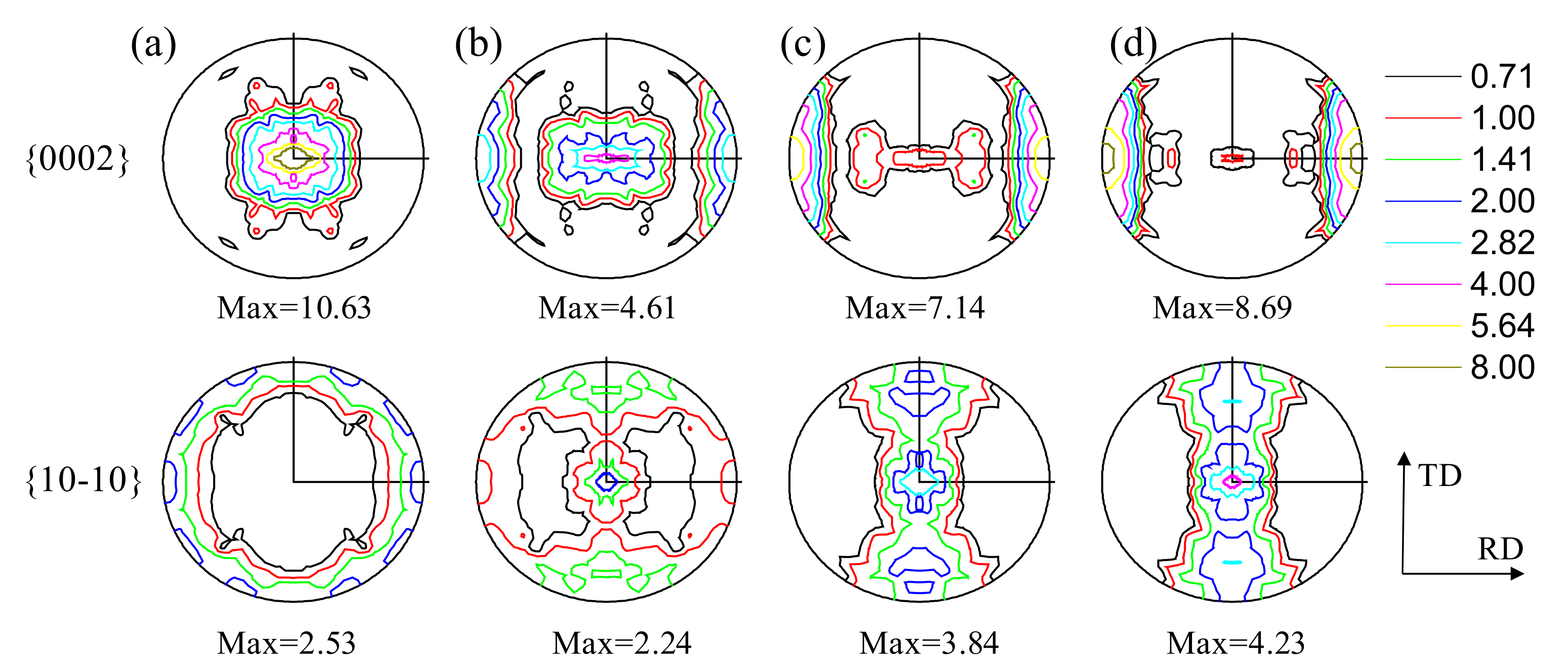
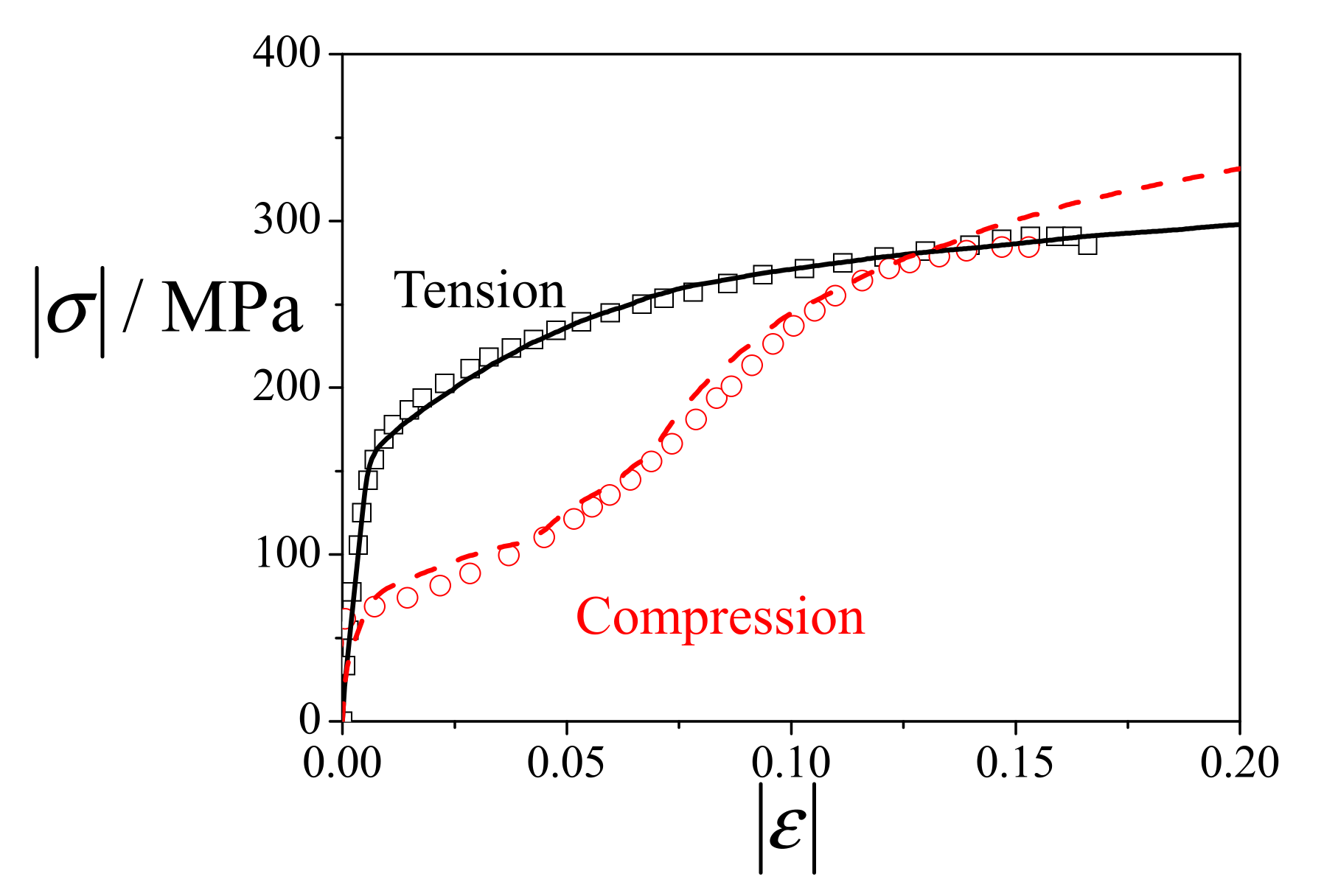

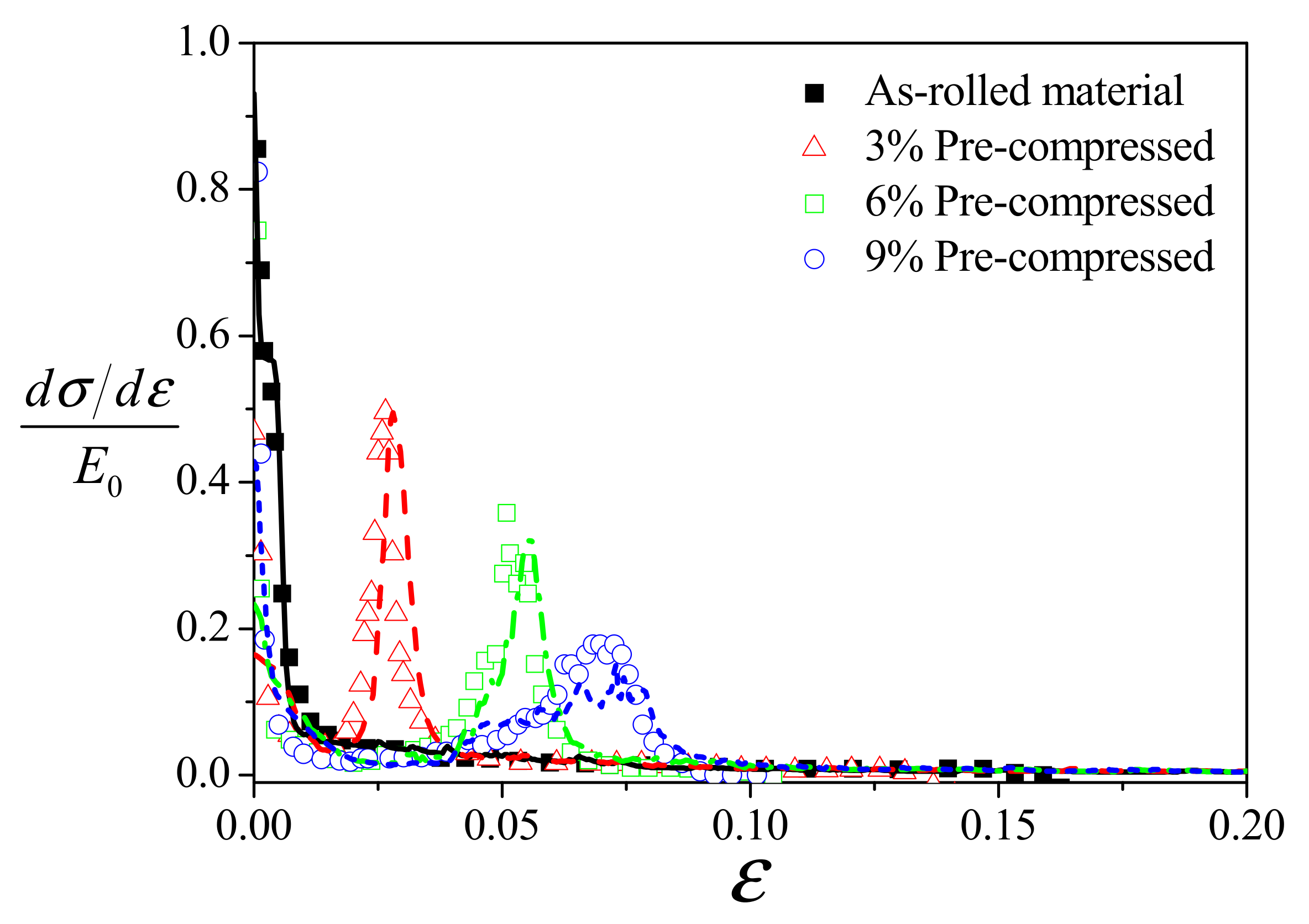
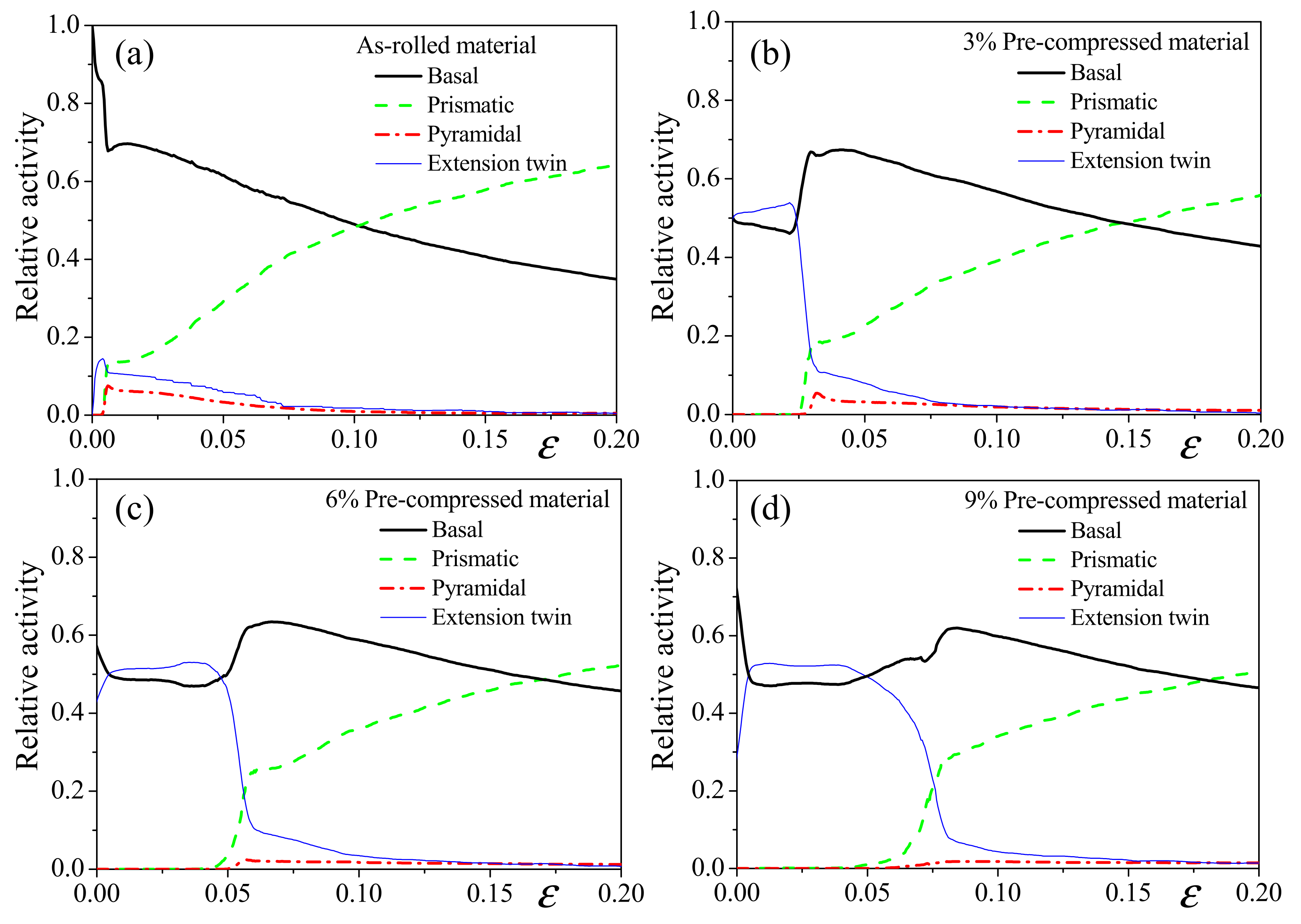

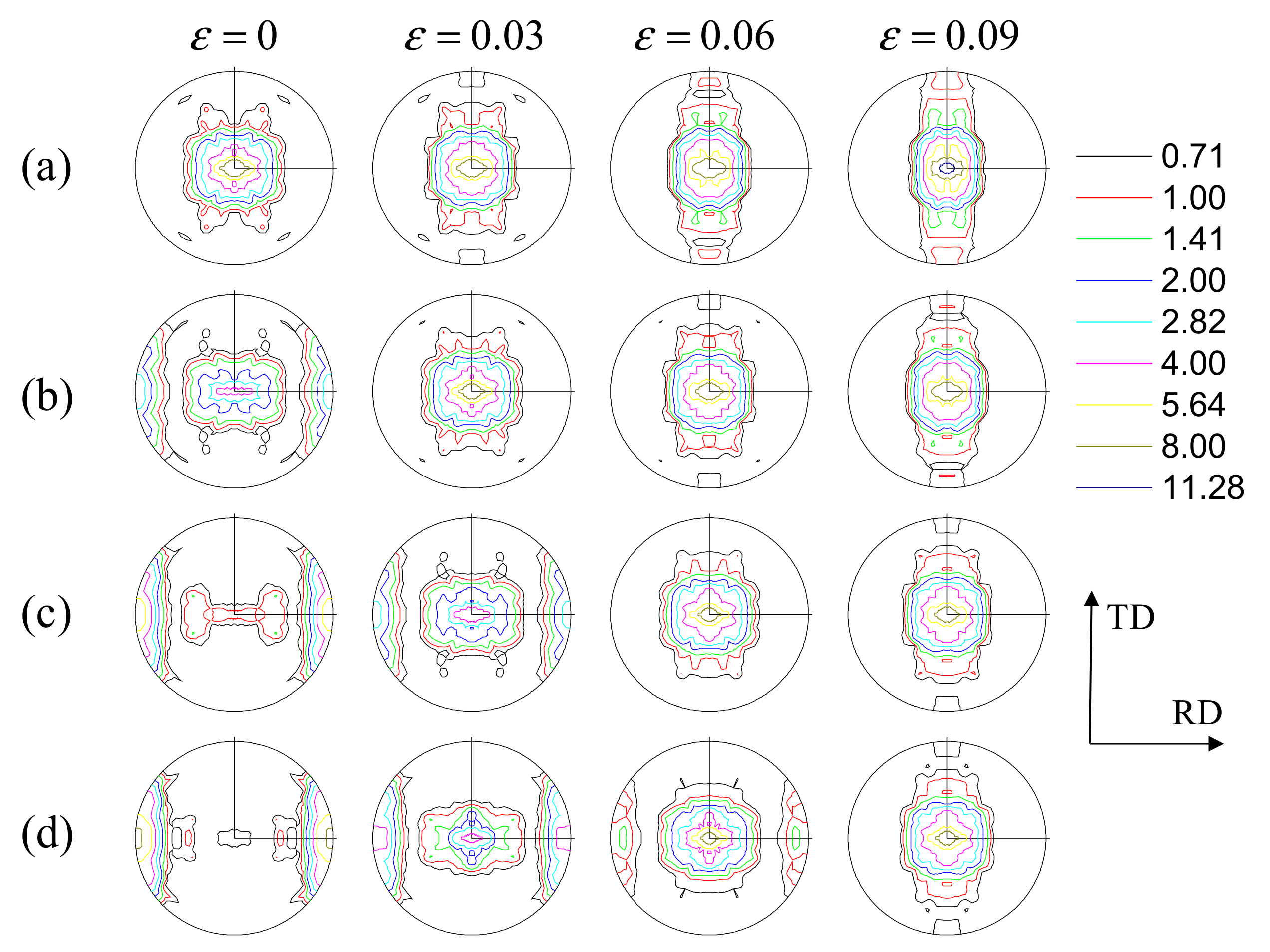
| Mode | |||||||
|---|---|---|---|---|---|---|---|
| Basal | 7 | 1 | 10 | 10 | 1 | ||
| Prismatic | 88 | 25 | 700 | 5 | 2 | ||
| Pyramidal | 90 | 90 | 500 | 0 | 1 | ||
| Extension twin | 15 | 10 | 50 | 10 | 1 | 0.7 | 0.85 |
| (detwinning) |
Publisher’s Note: MDPI stays neutral with regard to jurisdictional claims in published maps and institutional affiliations. |
© 2021 by the authors. Licensee MDPI, Basel, Switzerland. This article is an open access article distributed under the terms and conditions of the Creative Commons Attribution (CC BY) license (https://creativecommons.org/licenses/by/4.0/).
Share and Cite
Ma, C.; Duan, X.; Guo, X.; Qiao, H.; Zhang, L.; Wu, P. Numerical Study on the Effect of Pre-Strain on Detwinning in Rolled Mg Alloy AZ31. Materials 2021, 14, 6069. https://doi.org/10.3390/ma14206069
Ma C, Duan X, Guo X, Qiao H, Zhang L, Wu P. Numerical Study on the Effect of Pre-Strain on Detwinning in Rolled Mg Alloy AZ31. Materials. 2021; 14(20):6069. https://doi.org/10.3390/ma14206069
Chicago/Turabian StyleMa, Chao, Xing Duan, Xiaoqian Guo, Hua Qiao, Lianying Zhang, and Peidong Wu. 2021. "Numerical Study on the Effect of Pre-Strain on Detwinning in Rolled Mg Alloy AZ31" Materials 14, no. 20: 6069. https://doi.org/10.3390/ma14206069






